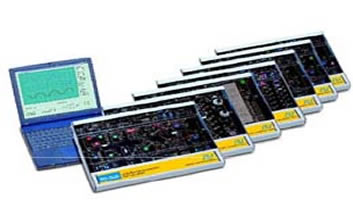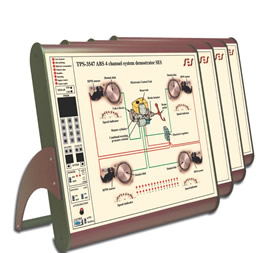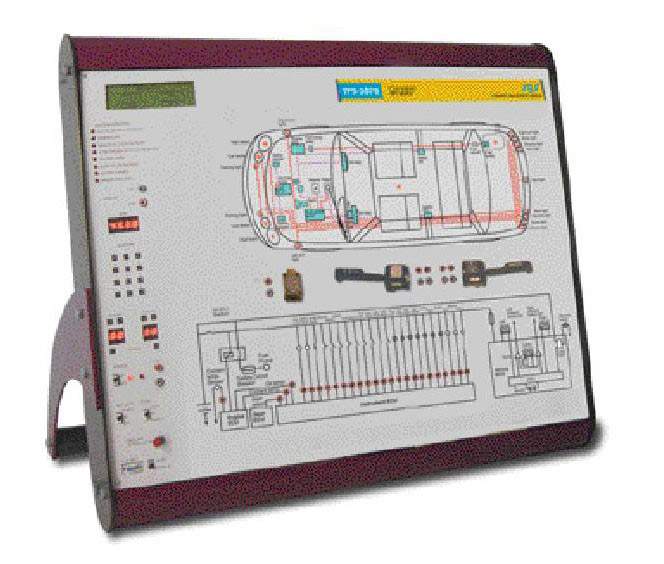- The innovating Autotronics training systems for studying the modern
car technologies accompanied with complete theory and experimental literature.
- The training systems composed of a line of desk training systems, a line of simulators and a line
of demonstrators that can all interconnected via CAN-Bus technology
and include fault insertion for troubleshooting and diagnostic experiments.
- Every training system is a stand alone system but can be connected
to a PC for using the PC as an oscilloscope.
- The demonstrators use real car components located on wide metal
panels to demonstrate how they function in the car and covers: Electrical
Lighting & Signaling, Engine Compartment Electrical Systems, Climate
Control, Automotive Air Conditioning, Ignition & Single Point Injection,
Ignition & Multi-Point Injection, ABS 4 Channel Brake System, ECO
- Diesel Fuel Supply.
- The desk training systems are used as simulators and electronics
trainers and cover: CAN-Bus & Instruments, Sensors & Transducers,
Vehicle actuators, Engine control systems, Alternator & Electronic
regulation.
|
|
|
TPS-352X Training Systems
|
|
TPS - 3521 - Can Bus Training System
is intended for classic experiments in the principles of Digital systems, BCD display and CAN BUS communication between several control units.
- Decimal system
- Binary system
- BCD display
- CAN BUS communication principles
- CAN BUS Signals
- CAN BUS protocol
- CAN BUS communication between control units
- Troubleshooting CAN-BUS systems.
|
TPS-3522 - Sensors Training System
|
TPS-3523-Vehicle Actuators Training Systems
deals with various Actuators, which controls the vehicle operation.
- Principles of various Actuators in the vehicle
- Actuators feedback signals pattern
- Measuring Actuator signals
- Consumer automatic test by controller
- The electrical window control
- The signaling light and emergency light control
- Intensity light control by PWM
- Intensity light control by DAC
- Light control by One Shot
- Troubleshooting Actuators function.
|
TPS-3526-Electronic Ignition Training System
is used to study various types of Electronic Ignition control, its components, its way of operation and the electronic principles behind them.
- Principles of Electronic Ignition system
- Types of Electronic Ignition Control systems
- Operation of Electronic Ignition systems
- The effect of the engine sensors on the ECU (Engine Control Unit) and on the ignition timing
- Troubleshoot Electronic Ignition systems.
|
TPS-3527-Electrical Charging Training System
is designed for studying the Electrical Charging system in the vehicle, its components, its way of operation and protection devices against High Voltage. It is also design for studying the Diesel glow plug control and electrical mirror control.
- Structure and operation of the alternator
- The alternator regulation
- Troubleshoot the Electrical charging system
- The glow plug control system and operation
- The electrical mirror control.
|
TPS-3528-Electronic Accessories training system
|
TPS-3530 Series Automotive Electrical and Electronics Training Modules
The TPS-3530 Automotive Training System Series introduces to the student the electrical and electronics systems
and components used in the modern car. It covers their principles, ways of function, characteristics,
usage in the vehicle systems and their operation during different conditions electrically, electronically and physically.
|
The modules enable the student to exercise measurements of the various applications,
troubleshoot faults in the components and learn about their effects on the system operation.
This training module series is especially designed for students in the field of Autotronics
The TPS-3530 series is composed of :
- TPS-3531 CAN-BUS trainer and module platform
- TPS-3532 Vehicle Sensors & Actuators Module
- TPS-3534 Electricity & Semiconductors Module
- TPS-3537 Ignition and Charging Module
- TPS-3538 Electrical Mirrors and Windows Module
|
|
TPS-3541 Lighting and Signaling Demonstrator
Demonstrates the lighting, signaling and other electrical systems, their components and wiring.
- Head and rear lights
- Parking lights
- Directional lights
- Back-up lights
- License light
- Interior lights
- Relay control circuits
- Containing relays
- Indicators (temperature, fuel, etc)
- Horn
- Wipers
- Wiper wash pump
- Blower and speed selector
- Engine condition sensors
- Indicators and switches
- Troubleshooting.
|
TPS-3545 Electronic Ignition Demonstrator
Demonstrates the DIS ignition system, its components and ECU control.
- Centralized injection system
- Sparks production
- Secondary circuit waveforms
- Triggering pulse
- Current restriction in primary circuit
- Ignition timing
- MAP sensor
- Engine load and ignition timing
- Engine temperature and ignition timing
- Knock control
- RPM measurements
- Sensors and valves system
- Electronic ignition system type E-DIS
- OBDII diagnosis connector
- Troubleshooting.
|
TPS-3546 Multipoint Injection Demonstrator
Demonstrates the multipoint injection system, its components and ECU control.
- Fuel delivery
- Fuel pump safety circuits
- Intake air mass measurement
- Air density and temperature
- TPS Throttle Position Sensor
- Electromagnetic injectors
- Injection duration and system operation
- Injection pulses analysis
- Injection duration at idle and at load operation
- Circuit cut-out during fuel overflow
- Idle air control
- O2 sensor
- Troubleshooting.
|
TPS-3547 ABS 4 Channel Demonstrator
Demonstrates the ABS system, its components, control and operation.
- Brake main system Components
- Electronic brake control
- Inductive RPM sensors
- Wheel speed calculation
- Vehicle acceleration
- Vehicle braking process
- Wheel lock
- Hydraulic Modulator
- ABS basic principles and operation
- ABS electrical circuits
- ABS control cycles
- Faults-diagnosis and repair
- Operation in various drive conditions
- Troubleshooting.
|
TPS-3572 Engine Sensors Simulator
Simulates the engine sensors, the injection and the ignition controlled by the ECU.
- Sensors operation: temperature, pressure, knock, flow, position, speed and oxygen
- Air control system including Idle air control
- Fuel delivery system and Injection system
- Ignition system and spark plugs
- Exhaust gas oxygen & temperature sensors
- Troubleshooting.
|
TPS-3573 Climate Control Simulator
Simulates the car climate control system, its principles, components, sensors, operation and controllers.
- Ambient temperature
- Outside temperature
- Incoming air temperature
- Cabin temperature
- Evaporators thermostat
- Maximum and minimum pressure
- Condenser blower state
- Blower speed
- Cabin air distribution
- Manual operation of the climate system
- Operation of mix and air distribution motors
- Blower operation irregularities
- Cut-off circuits
- Short circuits
- Operation at cold starting and under load
- Troubleshooting.
|
TPS-3574 Car Air Conditioning Simulator
Simulates the car air conditioning system, its principles, components, operation and controllers.
- Cold air production
- Charging and bleeding refrigerant
- Pressure and temperature relationship
- Operation and safety checks
- Compressor, evaporator, condenser expansion valve, fun, blower and pressure switch operation principles
- Refrigerant pressure and temperature
- Efficiency of the refrigerant cycle
- Regulation valve calibration
- Engine speed variation
- Troubleshooting.
|
TPS-3576 Electrical Systems Simulator
Simulates the car electrical components such as starter motor, alternator and charging system, battery, cooling system, their components, principles and operation.
- Testing the engine starting system
- Measuring the battery charging system
- Testing the idle state control systems
- Checking the cooling system effect
- Checking the cooling thermostat operation
- Troubleshoot.
|
TPS-3577 Suspension Simulator
The TPS-3577 Automotive Suspension Simulator is designed to
provide students with automotive training program introducing various systems and components in modern cars.
The simulator brings a comprehensive view of the entire system in the car,
the system's components and their interconnection,
functions, operation, signals, diagnosis and repair methods under hands-on safe activities.
|
The simulator includes real and simulated components controlled by internal controller that produces the
signals for measurement according to its internal simulating program or according to PC simulation programs.
The simulator's panel is with colored graphics clearly presenting the system components,
connections and inter-relations with test points for real measurements and LEDs describing the component status.
|
|
TPS-3578 Safety Systems Simulator
The TPS-3578 Automotive Safety Systems Simulator is designed to provide students with
automotive training program introducing various systems and components in modern cars.
The simulator brings a comprehensive view of the entire system in the car,
the system's components and their interconnection,
functions, operation, signals, diagnosis and repair methods under hands-on safe activities.
|
The simulator includes real and simulated components controlled by internal controller that produces the signals for
measurement according to its internal simulating program or according to PC simulation programs.
The simulator's panel is with colored graphics clearly presenting the system components, connections
and inter-relations with test points for real measurements and LEDs describing the component status.
|
|
TPS-3579 Transmission Simulator
The TPS-3579 Automotive Transmission Simulator is designed to provide
students with automotive training program introducing various systems and components in modern cars.
The simulator brings a comprehensive view of the entire system in the car,
the system's components and their interconnection,
functions, operation, signals, diagnosis and repair methods under hands-on safe activities.
|
The simulator includes real and simulated components controlled by internal controller
that produces the signals for measurement according to its internal simulating program or according to PC simulation programs.
The simulator's panel is with colored graphics clearly presenting the system components,
connections and inter-relations with test points for real measurements and LEDs describing the component status.
|
|
|
AT-3052 REAL CAR
Smart Gasoline Car Fault Insertion system
*
Internet-Based Practice System
*
Automotive Live Engine with Fault Insertion
The Smart Car
with a gasoline engine bridges classroom theory and laboratory
simulations with real-world diagnostic troubleshooting on live
gasoline cars. Once installed on a working vehicle, the Smart
Car allows the instructor to monitor student progress while
faults are been inserted from the student station courseware.
Students then apply their knowledge of vehicle systems to real
diagnostic measurements in order to correlate symptoms with
actual faults.
The software
presents students with real-life, hands-on experience in
diagnosing and repairing these faults. Through hands-on practice
in diagnostic procedures, students sharpen their problem-solving
skills. Training students in proper diagnostic procedure
translates into efficient, skilled technicians able to meet
certification standards and, ultimately, to generate revenue for
the shop or dealership. Two sets of courseware are provided to
support both learning and assessment modes.
The studentís level
of comprehension and proficiency may be tested and assessed
either by an instructor in the lab or by a remote assessor who
can communicate with the student through the Internet by using a
web camera and microphone that are controlled by the distance
monitoring software. | |
|
|









